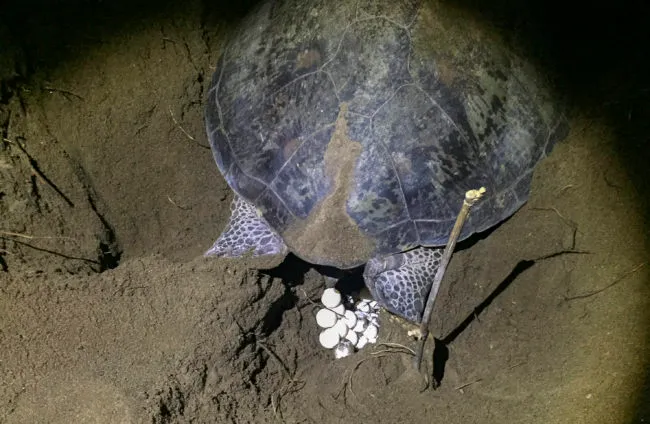10 ‘trans’, gender-bending animals that can change sex

Animals that can change sex.
There are species that have the ability to change their sex and/or appearance.
While there are over 1,500 species that exhibit homosexual signs, there are also animals that are ‘gender-bending’, with the ability to change how they look and/or their biology.
But in nature, we cannot determine if an animal is ‘transgender’ as it would need self-awareness and understanding of gender identification. We do not know if species beyond humans have such abilities.
However, it is clear that some animals can change their sex or at least their appearance to make them look like another sex.
So, which animals have ‘gender-bending’ or sex-changing traits?
Asian Sheepshead Wrasse
The documentary Blue Planet II, narrated by David Attenborough, explores the marine world.
One clip follows the path of a female Asian Sheepshead Wrasse and its ability to change sex to male.
Attenborough explained how the transformation works: “Over just a few months, particular enzymes inside her body cease to work and male hormones start to circulate.
“As time passes, her head expands, and her chin gets longer. A she has changed into a he. And with this comes a change in temperament.”
Watch the transformation below on Blue Planet II:
The footage went viral with many branding the species as the transgender fish.
ClownFish
While Finding Nemo may have fooled you, clownfish are actually among the species that can have natural sex changes, altering their reproductive functions.
They all begin life as male but are hermaphrodites and can change sex according to the status around them
In the clownfish world, female fish are larger and more dominant, and they lead their schools (groups of fish).
But when the dominant female fish dies, her male mate is next in line to lead the school.
So, in order to keep within their strict hierarchy, in which a dominant female clownfish is at the top, the male then changes his sex to female. He increases in size to match his deceased mate’s and can then reproduce as a female.
Then, the cycle continues as the non-dominant male of the school changes into a dominant male.
Marsh harrier
These birds have the ability to change how they look, rather than their biology.
40 percent of male Marsh Harriers change their appearance to resemble their female counterparts, adopting the new look approximately two years after birth.
The ‘gender-bending’ birds change the colour of their feathers from grey to brown (although they cannot change the colour of their eyes or size, as females are 30 percent bigger than males). This change is believed to be to prevent attacks.
Giant Australian cuttlefish
Similarly, Giant Australian Cuttlefish adopt the ability to change their appearance.
With the number of male cuttlefish grossly outweighing the number of females, they are in competition to find a mate to reproduce.
This means that males often fight each other, so it can be a dangerous game for the smaller male cuttlefish.
Watch the gender-bending species at work below:
So, for protection, they use their gift of camouflage to their advantage.
Those that would not do well in a fight often camouflage to look like the females. They draw in their tentacles and change their pattern, allowing them to slip passed the dominant cuttlefish and mate with the females without confrontation.
Red-sided garter snake
Red-sided garter snakes cannot change their sex nor their appearance, instead, they can give off the illusion that they are female.
The male snakes are able to attract other males by emitting female pheromones.
They do this to lure their male competitors away from the real female snakes.
This will increase their odds at successfully mating with a female, otherwise, there could be a swarm of many male snakes attempting to mate with just one female.
Sea snails
Endangered sea snails change their sex to improve their chances of survival.
They can change from male to female and female to male, adapting to changes around them.
Slipper limpets, for example, change their sex from male to female once in physical contact with another male.
Much like clownfish, they are born male but become female after they mature.
Lions
There are some lions that exhibit the physical characteristics of both genders.
Scientists discovered a ‘genderfluid’ lioness named Mmamoriri, who looks, acts and roars like a male.
Similar to a male lion, she has a mane as well as a deep, masculine roar.
The lioness was found on the plains of the Okavango Delta in Botswana, southern Africa.
Experts say her developments are due to evolution, as she adopted the characteristics of her male counterparts for survival.
Indeed, Mmamoriri is not the only lion to have such abilities.
Bearded Dragons
A study entitled The behavioural consequences of sex reversal in dragons found that bearded dragons are able to change their sex before they hatch in the egg.
If the incubation of eggs is exposed to temperatures greater than 31°C, male bearded dragons will change their sex to female.
Though the lizard will genetically remain a male, there will be changes to its gonadal sex as well as its structure and typical behaviour pattern.
Green sea turtles
Similarly, green sea turtles are also species with temperature-dependent sex determination.

If mother green sea turtles nest along especially warm sand, the hatchlings will likely be female as the embryos are also affected by high temperatures.
One study found that sea turtles that hatched from shores close to Australia’s Great Barrier Reef are now 99.8 percent female due to the rises in temperature.
In cooler areas, the ratio is slightly less, but with females still dominating at 65 percent.
Frogs
Frogs have been observed to change their sex but unlike other species, it doesn’t appear to be a natural process.
Instead, a common pesticide called atrazine, which is banned in Europe, has been altering frogs’ sexual development.
The weed killer, which often ends up in rivers where frogs dwell, is turning male frogs into female frogs by decreasing their production of testosterone and increasing estrogen in their bodies.
These feminised male frogs are even able to reproduce as natural females would by laying viable eggs after mating with male frogs.
